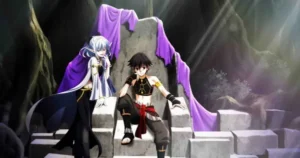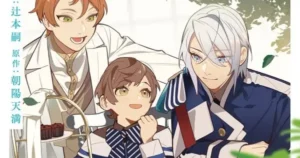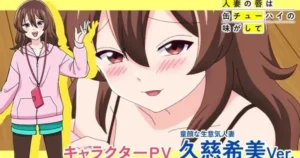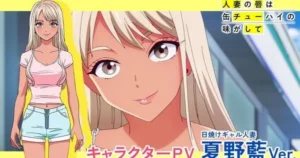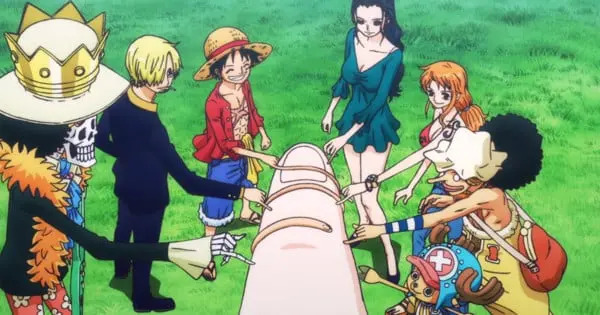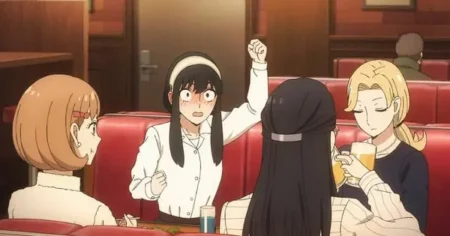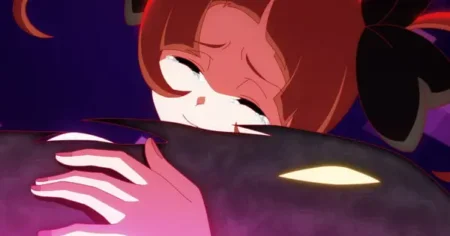The Fish-Man Island Saga, a pivotal arc in Eiichiro Oda’s One Piece, has concluded its remastered run in the “One Piece Log: Fish-Man Island Saga.” This retouched and condensed version of the original anime adaptation offers fans a fresh perspective on a story arc often viewed with mixed feelings. Let’s explore the saga’s narrative, themes, and impact on the broader One Piece universe.
Return to Sabaody: Setting the Stage
After a two-year timeskip, the Straw Hat crew reunites at Sabaody Archipelago, stronger and more determined than ever. This reunion marks a significant step in their journey toward the New World. The arc swiftly showcases the crew’s enhanced abilities as they effortlessly take down Pacifistas, machines that once posed a considerable threat. This display of power highlights their growth during their rigorous training.
The Straw Hats’ arrival at Sabaody is not without its share of comedic chaos. Familiar gags, such as the bickering between Zoro and Sanji and Chopper’s naivety, are present, adding a touch of nostalgia. The crew’s interactions with familiar faces and the re-establishment of their dynamics set a positive tone for their adventure into the New World.
Journey to the Deep Sea
With the Thousand Sunny now equipped for underwater travel, the Straw Hats set course for Fish-Man Island, located deep beneath the ocean’s surface. This descent into the deep sea presents unique challenges and breathtaking visuals. The journey is fraught with peril, as the crew encounters various sea creatures and navigates treacherous underwater currents.
The underwater setting of Fish-Man Island is visually stunning. Oda’s creativity shines through the unique designs of the island, its inhabitants, and the surrounding environment. The vibrant colors and intricate details create a sense of wonder and immersion, making the underwater kingdom a memorable location in the One Piece world.
Fish-Man Island: A World of Prejudice and Prophecy
Fish-Man Island is a complex society divided by deep-seated prejudice between fish-men and humans. This prejudice stems from a history of slavery and oppression, fueling resentment and animosity on both sides. The arc delves into these issues. It explores the roots of discrimination and the challenges of overcoming hatred.
Hody Jones and the New Fish-Man Pirates
The main antagonist of the Fish-Man Island Saga is Hody Jones, a fish-man driven by an extreme hatred of humans. Hody and his New Fish-Man Pirates seek to overthrow the Ryugu Kingdom and establish a new order based on fish-man supremacy. Hody’s actions are fueled by a desire for revenge and a belief in the inherent superiority of fish-men.
Hody’s character represents the dangers of unchecked hatred and the cycle of violence it perpetuates. His backstory reveals how his beliefs were shaped by the prejudices of his environment. He becomes a symbol of the destructive consequences of discrimination. While some find Hody to be a weak villain, his narrative impact on the arc and his role in exploring themes of racism should be considered.
The Ryugu Kingdom and the Legacy of Otohime
In contrast to Hody’s extremism, the Ryugu Kingdom, led by King Neptune, seeks to foster peaceful relations between fish-men and humans. Queen Otohime, Neptune’s late wife, played a crucial role in advocating for coexistence and understanding. Her efforts to collect signatures for a petition promoting human-fish-man relations highlight her commitment to a better future.
Otohime’s assassination is a pivotal moment in the arc, symbolizing the challenges of overcoming prejudice and the fragility of peace. Her death reignites the cycle of hatred and sets the stage for Hody’s rebellion. Despite her tragic fate, Otohime’s legacy continues to inspire hope and serves as a reminder of the importance of tolerance and compassion.
Shirahoshi and the Ancient Weapon Poseidon
One of the most significant revelations of the Fish-Man Island Saga is the introduction of Shirahoshi, the mermaid princess. She is revealed to be the ancient weapon Poseidon. Shirahoshi possesses the power to communicate with and command sea kings, massive creatures capable of causing widespread destruction. Her abilities make her a target for those seeking to control the world’s oceans.
Shirahoshi’s character represents the potential for both great power and great responsibility. As Poseidon, she holds the key to controlling the seas, but she must also learn to harness her abilities wisely and use them for the benefit of all. Her connection to the sea kings and her role in the ancient prophecies add a layer of mystery and intrigue to the One Piece storyline.
Luffy’s Declaration and the Future of Fish-Man Island
The climax of the Fish-Man Island Saga sees Luffy confronting Hody Jones in a fierce battle. Luffy defeats Hody, demonstrating the Straw Hats’ overwhelming strength and protecting the Ryugu Kingdom from destruction. In the aftermath of the battle, Luffy makes a bold declaration. He claims Fish-Man Island as his territory, placing it under his protection and challenging the authority of the World Government.
Luffy’s declaration has significant implications for the future of Fish-Man Island and the One Piece world. It establishes a new power dynamic in the New World and sets the stage for future conflicts and alliances. Luffy’s actions also signal his growing influence and his commitment to protecting those who cannot protect themselves.
Jinbe’s Choice and the Connection to Big Mom
During the Fish-Man Island Saga, Luffy invites Jinbe, a whale shark fish-man and former member of the Seven Warlords of the Sea, to join the Straw Hat crew. Jinbe declines the offer at this time, stating that he must first settle some unfinished business with Big Mom, one of the Four Emperors.
Jinbe’s connection to Big Mom adds another layer of complexity to the Fish-Man Island Saga. It highlights the political tensions and power struggles in the New World. Jinbe’s decision to sever ties with Big Mom sets the stage for his eventual joining of the Straw Hat crew and further complicates the Straw Hats’ relationship with the formidable Emperor.
Themes and Analysis
The Fish-Man Island Saga explores several important themes, including:
- Prejudice and Discrimination: The arc delves into the deep-seated prejudice between fish-men and humans, examining the historical roots of discrimination and its destructive consequences.
- The Cycle of Hatred: The saga illustrates how hatred can perpetuate itself, leading to violence and oppression. It emphasizes the importance of breaking this cycle through understanding, forgiveness, and reconciliation.
- Hope and Coexistence: Despite the challenges and conflicts, the Fish-Man Island Saga offers a message of hope and the possibility of coexistence between different groups. It highlights the importance of empathy, compassion, and working towards a better future for all.
- Prophecy and Destiny: The arc introduces the concept of ancient prophecies and the role of destiny in shaping events. Shirahoshi’s identity as Poseidon and Madame Sharley’s predictions add a layer of mystery and intrigue to the story.
Reception and Impact
The Fish-Man Island Saga has been a subject of debate among One Piece fans. Some criticize the arc for its slow pacing and perceived lack of compelling villains. Others praise its exploration of complex themes and its contribution to the overall One Piece narrative.
Criticisms
One common criticism of the Fish-Man Island Saga is its pacing. Some viewers felt that the arc dragged on for too long, with excessive exposition and repetitive plot points. The retouched and condensed version of the arc in “One Piece Log: Fish-Man Island Saga” addresses these pacing issues, streamlining the story and focusing on key moments.
Another criticism is the perceived weakness of the villains, particularly Hody Jones. Some felt that Hody lacked the depth and charisma of previous One Piece antagonists. Others argue that Hody’s character is intentionally shallow, representing the mindless hatred and destructive consequences of prejudice.
Praises
Despite the criticisms, the Fish-Man Island Saga has also received praise for its exploration of complex themes and its contribution to the overall One Piece narrative. The arc’s examination of prejudice and discrimination is particularly noteworthy, as it tackles sensitive issues with nuance and depth.
The introduction of Shirahoshi and the ancient weapon Poseidon is another highlight of the Fish-Man Island Saga. Shirahoshi’s character adds a new dimension to the One Piece world, and her connection to the sea kings opens up exciting possibilities for future storylines.
Conclusion
The Fish-Man Island Saga is a complex and thought-provoking arc in One Piece. While it may have its flaws, it explores important themes, introduces compelling characters, and sets the stage for future events in the One Piece world. The “One Piece Log: Fish-Man Island Saga” offers fans a fresh perspective on this pivotal arc, streamlining the story and enhancing the visuals. Whether you love it or hate it, the Fish-Man Island Saga is an essential part of the One Piece experience.


